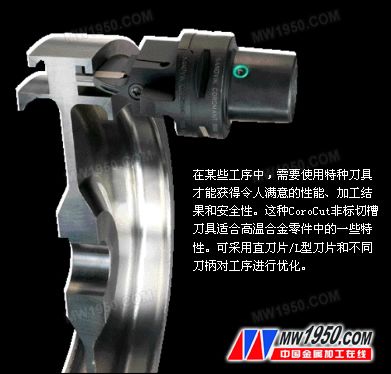Subtle changes or major improvements in standard cutting tools can have a huge impact on the machining results. Some part features require non-standard tools to be machined or cut more efficiently. Tools can be dedicated to an application in a number of ways: specially designed tools, standard-like tools or tool modular options.
Cutting and grooving involves many different types of cutting, often without the use of standard tools.
Required tool change - non-standard tool
Most metal cutting operations can be optimized with standard tools, but in some cases, the Tailor Made Product option is required to match specific characteristics, dimensions, and so on. Standard tools offer a high degree of versatility, making selection and application relatively straightforward. Standard tools are almost always the best solution for small batches and one-time production, but there are often exceptions, such as when the part features include dimensions that are beyond the standard tool, high complexity or need for superior stability and reachability. Sexuality. Some parts cannot be machined using standard or semi-standard tools (Tailor Made Product), so specially designed tools must be used.

In high-volume production, it is generally necessary to further optimize the process, because if each part can save a small amount of processing time, then the accumulation will be considerable. A few seconds per cut means that many hours of processing time can be saved each year. Proper application of standard tools is the best solution in most cases, but in some cases there may be optimization possibilities - specially designed tools are required.
Many industries involve non-standard tools, the industry with the highest proportion of use is the automotive industry, which is generally used to optimize processes in order to save time in mass production of parts. The use of non-standard tools in the power generation industry is also very frequent, and the complex part characteristics of the industry require specially designed tools. The aerospace industry is a rising star, and many solutions require specialized modular tools.
Manufacturing non-standard tools and providing high performance requires authoritative and experienced resources to best use the quotation and tool designer's skills, CAD/CAM programming and manufacturing capabilities. The mechanism for pre-defining non-standard tools (based on variables that constitute non-standard tools) has a huge impact. Systematized variables at hand are the basis for non-standard solutions. A semi-standard custom tool (Tailor Made Product) may be covered here, where the tool is somewhat different from the standard. They may have to use predefined non-standard tools (designed for the process) to cut or obtain shorter cutting times.
Standard class solution
Grooving and cutting applications are very extensive, especially in terms of the size and shape of the slots, so a dedicated solution is generally required. Changes beyond the various standard blades are mostly achieved through semi-standard custom shape options, in which the blade blanks can be of different radii, width, angle and length. The blade material also needs to be tailored to the specific material or application, and the insert seat, cutting edge rounding, relief angle and tolerance are some of the required options.

Tailor Made Product cuts and grooving shanks also improve performance, machining results, tool life and time required for tool change. In the cutting and grooving process, an enhanced blade or a better toolholder for a particular tool overhang has a considerable impact on stability and the application of higher cutting parameters. The main application range is from mass production to mass production, and the most suitable tool for the process can recover the total processing cost faster.
In terms of part characteristics, Tailor Made Product's custom blades are not always satisfactory if the groove size is outside the processing range and the complexity is high and the problem of poor accessibility needs to be overcome. This can happen in high-volume production. For example, in the machining of small parts, the shaft and the cylinder require extremely high-precision grooving, or the grooving is very close to the shoulder and requires a certain chamfer. When turning hardened parts, stability is critical to the machining results. The measures taken include the shank reinforcement and the CBN insert with secure clamping.
| 1 | 2 | Next page |
T Handle Torx Set,T Handle Hex Key,T Handle Hex Key Set,Best T Handle Hex Set
henan horn tools co.,ltd. , https://www.horn-tool.com